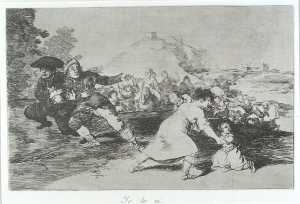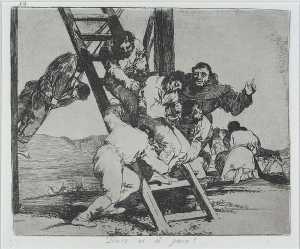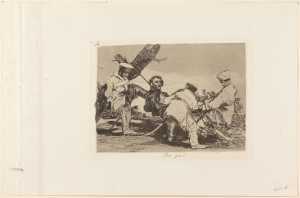
Goya's 'Disasters of War'
Goya was known to his contemporaries chiefly as a court painter but today he is best known for his outspoken vision of society, which he expressed in prints and drawings. The series ‘Los Desastres de la Guerra’ (The Disasters of War) depicts events during the Peninsular War of 1808 to 1814.
What is depicted?
Between 1808 and 1814 the Spanish, Portuguese and English fought Napoleon’s France in the Peninsular War. In the first part of Goya’s series we witness the scenes of war: wounded soldiers, rapes, executions and mutilated corpses. These searing episodes are followed by images of the famine in Madrid in 1811-1812. The last part consists of allegorical compositions interpreted as a critique of the reign of Ferdinand VII after the war.
Technique and edition
Francisco Goya worked on his ‘Desastres’ between 1810 and 1820. He never had it published, however, probably because of the difficult political situation. Only two of his four print series came on to the market during his lifetime. ‘Los Caprichos’ (Caprices) and ‘La Tauromaquia’ (Bullfight) were published for the first time in 1799 and 1816 respectively. ‘Los Desastres’ and the fourth series ‘Los Proverbios’ (Proverbs) were published by the Royal Academy of San Fernando in Madrid thirty-five years after his death.
The prints in the ‘Desastres’ show a multitude of printing techniques and Goya’s highly individual approach. The artist usually began with an etched outline of the composition. The shadow passages and tones creating the depth were then obtained with the addition of aquatint or lavis. Drypoint or burin strokes introduced the final touches, and a burnisher was used to emphasise the highlights. In some cases (e.g. plates 4 and 59), Goya would reverse this process, starting by applying aquatint to the whole plate, followed by the addition of etched lines and burnished highlights.


Analysing and describing the precise technique that Goya used is extremely difficult, even for specialists. Some nuances of his individual technique, such as the subtle tonal changes, the drypoint details and strong chiaroscuro contrasts are found only in the first edition of ‘Desastres’. The prints presented in the exhibition come from this first edition, which was printed in Madrid in 1863. Some of the sheets are extremely rare and early versions with spelling mistakes in the titles, which were not corrected until later, when the first edition was printed.
Other prints
Around 1820 Goya gave a set of proofs of ‘Los Desastres’ to his friend, Augustín Ceán Bermúdez. Apart from the published eighty scenes, this album (today in the British Museum) contains two additional compositions (plates 81 and 82) and three smaller etchings of prisoners. The additional five prints were never part of the posthumous editions. One of these so-called ‘Little Prisoners’ was published in the magazine Gazette des Beaux-Arts in 1867.
Motifs
The motif of the garrotted man is also found in two prints (34 and 35) in the series ‘Los Desastres de la Guerra’. This is probably Goya’s first secular etching to his own original design. Prior to this the artist had only made prints of religious subjects and reproductions of paintings by Diego Velázquez (Sevilla 1599 - Madrid 1660), the greatest Spanish artist before him.



'Los Proverbios'
In 1862 the Royal Academy of San Fernando in Madrid acquired eighty copperplates of the ‘Desastres’ and eighteen of the ‘Proverbios’ series. The Academy members decided to use the plates and an edition of five hundred sets was printed and put on to the market. This first edition of the ‘Desastres’ appeared in 1863 with a title page similar to the one of the ‘Proverbios’ issued a year later.
The meaning of Goya’s last print series, ‘Los Proverbios’, is not entirely clear. It is believed that they depict popular proverbs or fables. The scenes are full of bizarre but horrific and terrifying figures, phantoms, giants and flying creatures. In literature the series is also known as ‘Los Disparates’ (Follies) on the basis of the handwritten titles on a number of very rare proofs.



Francisco Goya, Otra locura suya en la misma plaza (Another madness of his in the same ring), 1816, etching, aquatint, dry-point, burnisher and burin on paper, donation: Dr. A.J. Domela Nieuwenhuis 1923
‘La Tauromaquia’
Goya’s print series ‘La Tauromaquia’ includes scenes from the history of bullfighting. Both devotee and critic, the artist appears to have had a somewhat more ambivalent attitude towards this Spanish tradition than was previously assumed. The title of this composition is linked to the previous plate in the series illustrating a feat performed by the bullfighter Martincho in the ring at Saragossa.
Proofs
Goya’s working method called for the making of many proofs so that he could check changes on the copperplate. This is the working proof of plate 61 from the ‘Los Caprichos’ series. Although the composition is already in its finished state, it lacks the engraved title and the number. The change to the original title is typical of the importance that the artist attached to titles.

Draughtsman
Apart from being a productive painter and printmaker, Goya was also a passionate draughtsman. He created eight albums of drawings, each with its own individual character. Museum Boijmans van Beuningen possesses a collection of five drawings by the artist. The two drawings in brown coloured ink shown here come from the album that has been linked to the times of the Peninsular War (1808-1814).


Four years before his death, Goya immigrated to France. The last drawing comes from this period. Although many years had passed since the Spanish War of Independence, the drawing below is reminiscent of the harrowing scenes from the ‘Los Desastres’. The desperate pose of the kneeling man closely resembles the dramatic gestures and expressions of many figures from the series finished almost a decade earlier.
The drawing of an old woman dancing comes from the album made probably some years after the end of this war. The numbers, titles and independent character of the drawings in this album suggest that they might have been intended as designs for a new print series along the lines of the ‘Caprichos’.




























